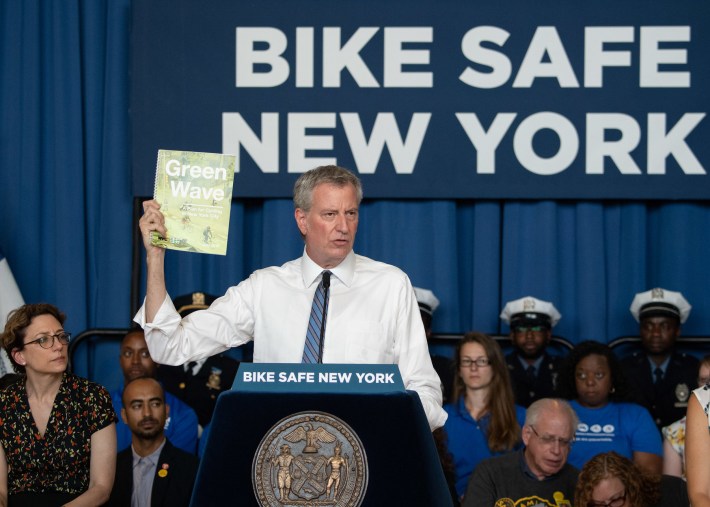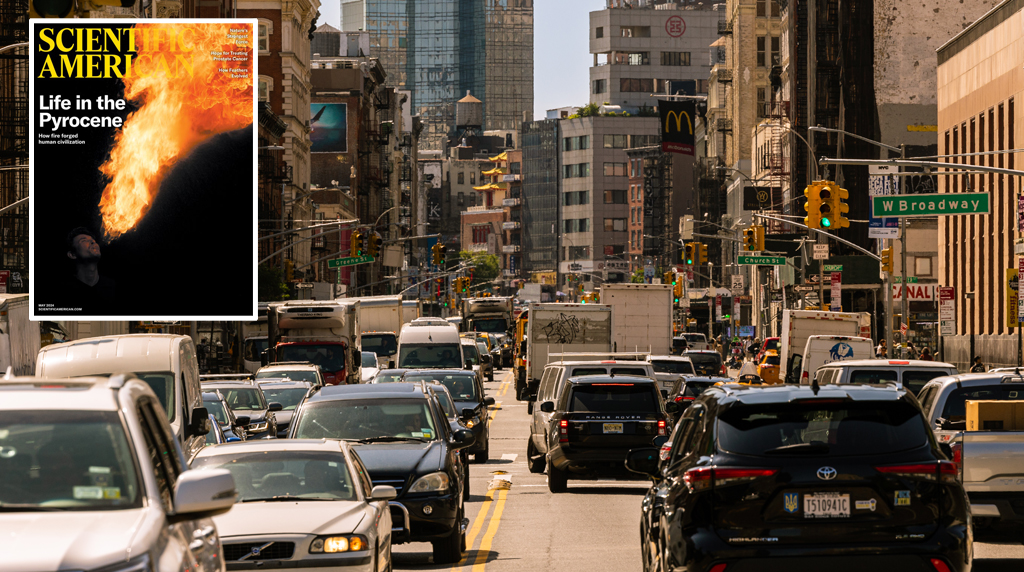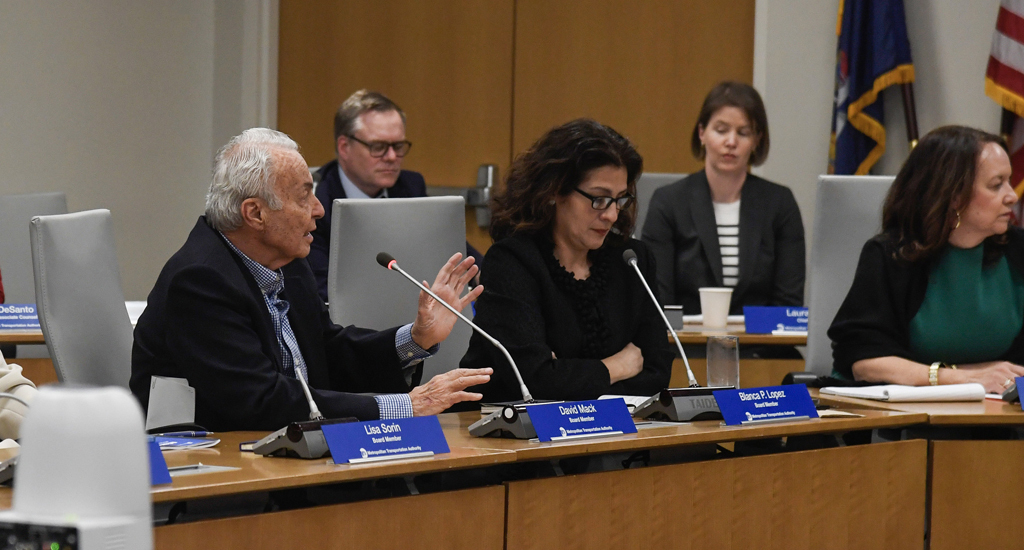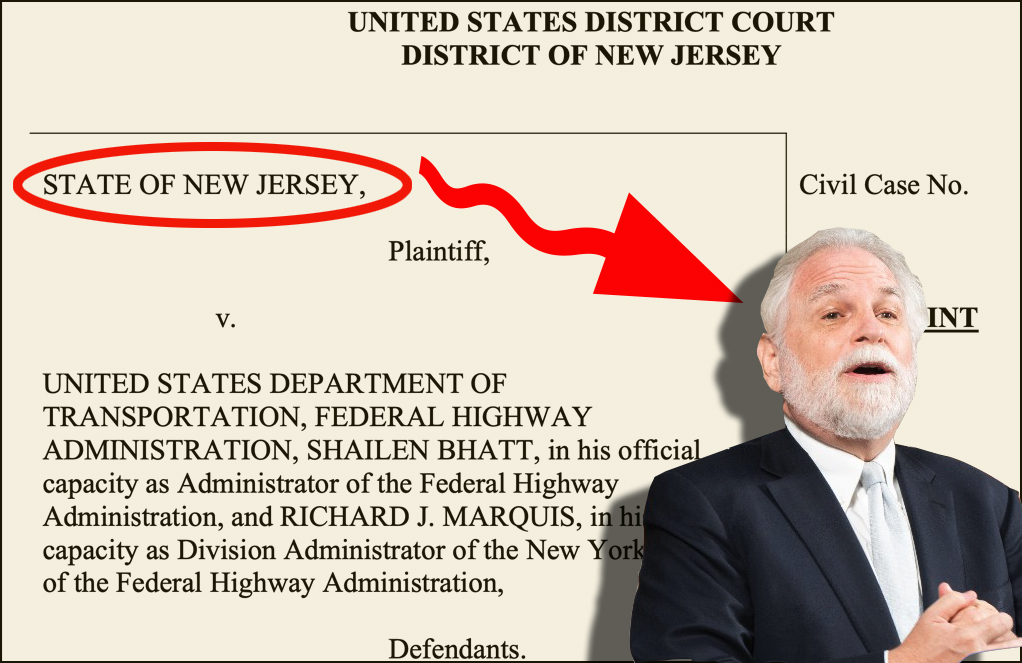De Blasio’s ‘Green Wave’ Finally Addresses the Problem…
11:40 PM EDT on July 25, 2019

The mayor listened to the devil on his shoulder when it came to budget cuts.
The plan released by Mayor de Blasio to stem the blood tide on city streets this year is an expansive one that includes more miles of protected bike lanes, better-designed intersections, amped up police enforcement on rogue truckers and bike lane blockers and more education for inept drivers.
Safe-street and bike advocates, who started begging for the mayor to do something long before the 17th cyclist was killed this year, say the long-overdue — and not truly visionary — plan will nonetheless make a clear difference.

“We think it's a very strong plan. It's not perfect, but it has some critical elements,” said Transportation Alternatives Deputy Director Marco Conner. “The Department of Transportation knows that it takes a bold set of infrastructure and policy changes to make our streets safe for all New Yorkers, so we're pleased to see Mayor de Blasio doubling down on his mandate to save lives and empowering the DOT to bring sweeping changes to our streets.”
In addition to raising NYC’s target for creating protected bike lanes, we’re pleased that the new 🚲 plan and press release issued by @NYCMayor today respond to a variety of issues recently raised by #bikenyc groups & community pic.twitter.com/iuKcMf9rgf
— Bike New York (@bikenewyork) July 25, 2019
Hizzoner announced the $58-million plan, dubbed the "Green Wave," on Thursday at a school in Bay Ridge — near where his DOT will soon install the neighborhood's first protected bike lane.
The plan comes just a few weeks after more than 1,000 people staged a "die-in" in Washington Square Park to demand that drivers citywide “Stop killing us!” — and more than two months after many of those same bikers and advocates packed the steps of City Hall to declare a state of emergency for the mayor's signature Vision Zero initiative.
Flanked by bike advocacy groups Transportation Alternatives, Families for Safe Streets, Bike New York, de Blasio unveiled the highlights of his plan, which include mostly expanded versions of his existing initiatives:
30 miles of protected bike lanes each year
The city is committing to build 30 miles of protected bike lanes across the five boroughs each year, which would be about 10 miles more than last year, though only five miles more than the mayor's record year in 2017. Thirty miles would represent a 50-percent increase from last year, but it is still far short of the 50 miles of protected bike lane sought by Council Speaker Corey Johnson and the 100 miles of protected bike lane sought by Council Member Ydanis Rodriguez, who was on hand to support the mayor on Thursday (albeit to also put in a plug for his far more rapid expansion of the bike lane network).
One of the first new protected bike lanes slated to be installed will be along Seventh Avenue in Bay Ridge — a neighborhood that lacks any on-street protected lanes. The city also committed to restoring a protected bike route on Dyckman Street in Upper Manhattan — almost a year after DOT hastily ripped it up because of a backlash from local pols.
By the end of 2021, DOT expects to install more than 80 new miles of protected bike lanes. And by 2030, it plans to connect major gaps in order to create a citywide bike-lane network.
DOT plans to build 75 miles of this bike infrastructure in 10 communities it identifies as Bike Priority Districts, such as Maspeth, Bedford-Stuyvesant, and Borough Park — neighborhoods that comprise a disproportionately high rate of cyclist fatalities. DOT also will boost its staff and add 80 more people focused on building out the bike network.
Truck enforcement
Truck drivers have killed the last four cyclists who were mowed down this year, including Aurilla Lawrence, Robyn Hightman, Devra Freelander, and Alex Cordero.
Historically, trucks have been involved in about 30 percent of cyclist fatalities, but this year that number shot up to more than 40 percent, according to DOT Commissioner Polly Trottenberg.
The NYPD will launch a crackdown against dangerous truck drivers and target 100 of the most dangerous intersections in the city, slapping drivers with tickets if they put cyclists in danger.
“All of them will receive additional NYPD enforcement with a special focus on trucks. I want everyone that drives a truck in this city to know the NYPD will be watching and they will take action if any trucker does the wrong thing and endangers a bicyclist,” de Blasio said.
Trottenberg added that DOT will work closely with the trucking industry in order to ensure that drivers get training to boost their awareness of cyclist and pedestrians.
Better design
The majority of fatal and serious-injury crashes happen at intersections, where cars and cyclists are forced to mix and compete for space on the road — so the city is vowing to install traffic-calming measures at 50 of the most dangerous intersections in the city that have the highest rates of crashes.
Some of these improved designs will include more bike boxes, which allow cyclists to sit ahead of cars at intersections, and more green paint to act as a visual cue to drivers that cyclists are there.
DOT also commits to creating parking protected bike lanes where possible — or what Trottenberg described as the "hardening" of bike lanes — so that cars cannot drive into them. Drivers often stray into, and park on, bike lanes that are unprotected, often with deadly consequences. Last summer, Madison Lyden was forced out of the painted bike lane on Central Park West because of a parked livery car and was hit and killed by a private sanitation truck driver.
“We're also going to be hardening more of our bike lanes with more bollards and other devices to keep cars out of them,” said Trottenberg.
17 cyclists have been killed by motorists in NYC this year. Victims are often blamed for riding outside of the bike lane. But when lanes are obstructed, cyclists are forced to ride outside of them. I made a video to illustrate this. https://t.co/zWNfL2KTwA #bikenyc @TransAlt pic.twitter.com/0BElLViIia
— Will Geary (@wgeary) July 25, 2019
Green Wave
In Manhattan, the city will pilot a program called the "Green Wave," which will time green lights so that cyclists can ride through as many as possible without having to stop.
One exciting bit of news in @NYCMayor's Green Wave #BikeNYC plan: @NYC_DOT will "accelerate completion" of Bklyn's Fourth Ave bike lane. But does "accelerate" mean coming close to the original schedule, bc project was supposed to have been done by now? https://t.co/fdEM4WmyvZ pic.twitter.com/O8oMhPA58D
— David Herman (@DHermanStudio) July 25, 2019
Trottenberg says that she’d like to expand the program to other high-biking corridors, though she did not publicly name any actual streets. It is well documented that on streets such as Bergen Street in Brooklyn, cyclists outnumber cars during the morning rush hour as bikers make their way to the Manhattan and Brooklyn bridges. The roadway is fairly useless as a through street for drivers, however. Transportation Alternatives and other cycling advocacy groups recently called for just that approach.
“We’re timing lights so cyclists can have a smooth ride with less stopping, less having to stop an intersection — it also has the effect of calming traffic," Trottenberg said. "We will start that pilot this year and hopefully roll it out to other corridors around the city where we see a lot of cycling.”
Permanent crackdown
The NYPD's three-week enforcement blitz on reckless drivers and bike lane blockers is going permanent, de Blasio said, confirming Streetsblog's earlier scoop.
Cops handed out more than 8,600 summons in the first three weeks of July — more than double the amount they wrote in the same time period last year.
"I am emphasizing this as an open-ended effort. It will continue until we see the results that we need," he said.
Safety 101
As part of the new bike-safety plan, the city also will conduct more outreach to motorists on how to drive more safely and to look out for pedestrians and cyclists on the road.
"You will see more public education, and both those things are meant to change the behavior of motorists, which we have to do. There's still so much work to be done," the mayor said. "I know we have changed motors behavior in some ways, but we have so much more to do. Education is part of it, but enforcement is another way of educating and you will see plenty of enforcement."
Julianne Cuba joined Streetsblog in February, 2019, after three years covering local news and politics at The Brooklyn Paper. There, she also covered the notoriously reckless private carting industry and hit-and-runs. A 2015 graduate of Stony Brook University’s School of Journalism Master’s Program, she lives in Brooklyn. Julianne is on Twitter at @julcuba. Email Julianne at julianne@streetsblog.org
Read More:
Stay in touch
Sign up for our free newsletter
More from Streetsblog New York City
Komanoff: A ‘Noise Tax’ Can Ground NYC Helicopters
A proposed $400 “noise tax” on “nonessential” flights is a start — and it will work.
Thursday’s Headlines: Welcome to the War on Cars, Scientific American
Our favorite story yesterday was this editorial in an unexpected place. Plus other news.
Meet the MTA Board Member and Congestion Pricing Foe Who Uses Bridges and Tunnels For Free Every Day
Mack drives over the transportation authority's bridges and tunnels thanks to a rare perk of which he is the primary beneficent.
Randy Mastro Aspires to Join Mayor’s Inner Circle of Congestion Pricing Foes
The mayor's reported pick to run the city Law Department is former deputy mayor under Rudy Giuliani and notorious foe of bike lanes and congestion pricing.
Donald Shoup: Here’s a Parking Policy That Works for the People
Free parking has a veneer of equality, but it is unfair. Here's a proposal from America's leading parking academic that could make it more equitable.




